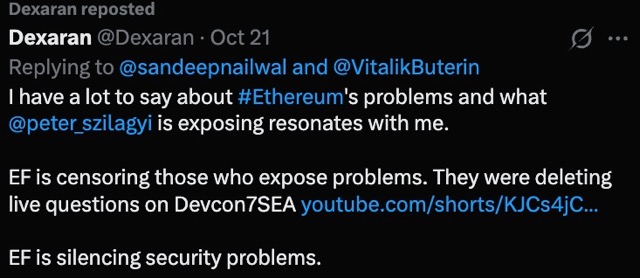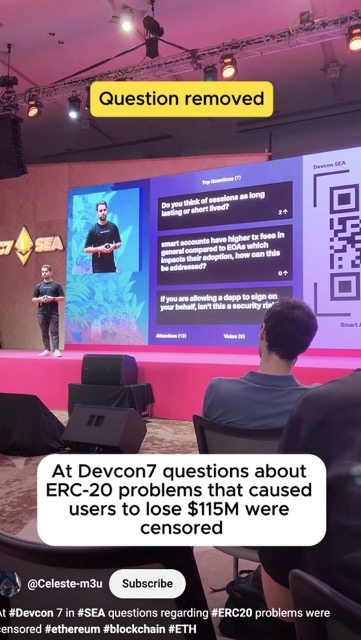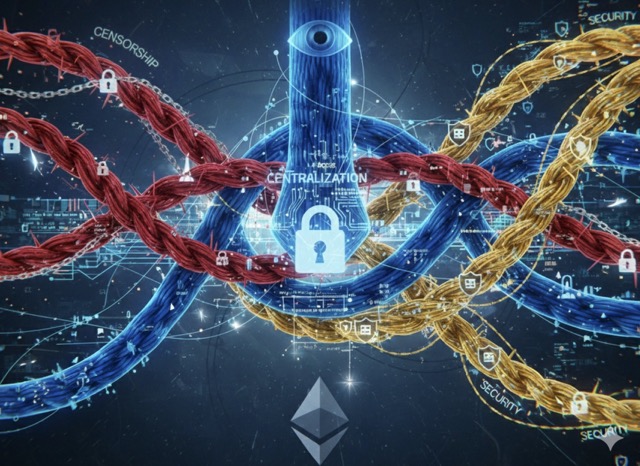Censorship, Centralization, and Security: The Moment Ethereum Looked in the Mirror
On October 21, a quiet but revealing moment unfolded on GitHub. Ethereum core developer Peter Szilágyi published a post warning about the growing centralization of Ethereum’s infrastructure, then deleted it soon after. Security researcher Dexaran responded publicly, questioning why discussions about decentralization risks seem to vanish when they become uncomfortable...
Dexaran's remarks, shared across social media, reignited debate about how Ethereum handles internal criticism and transparency:


Here is the copy of the long memo and Dexaran's deleted comment.
That exchange echoed an earlier moment at Devcon7, where Dexaran’s live ERC-20 security questions were removed from the event’s Q&A display mid-session. The video evidence showed how questions about vulnerabilities - linked to more than 115 million dollars in user losses - were quietly filtered out of Ethereum’s biggest public forum see for yourself:

Link to Q&A Session at Devcon7: https://www.youtube.com/shorts/KJCs4jCBALg?feature=share
Together, these two moments form a mirror Ethereum can’t ignore. They expose a deeper tension between decentralization and control, transparency and optics forcing the question: what does censorship resistance mean when criticism itself can disappear?
The events surrounding Peter’s deleted post and Dexaran’s censored questions highlight the same fault lines that have shadowed Ethereum since its early years. The network’s ideals of openness and permissionless participation now face the real-world pressures of infrastructure dependence, organizational influence, and selective communication.
What the Mirror Reveals
- Censorship: Ethereum’s permissionless ideal collides with real-world dependencies. When most nodes and endpoints rely on a few centralized providers, the network inherits their weaknesses and biases.
- Centralization: Influence increasingly concentrates in foundations, client teams, and infrastructure providers. The question remains whether governance truly reflects community consensus or institutional direction.
- Security: Real security goes beyond cryptography. It depends on transparency, rapid patching, and open disclosure—resisting quiet fixes and filtered messaging that undermine trust.
Case Studies and Signals From the Community
- Dexaran’s posts and Peter Szilágyi’s deleted GitHub comments highlighted the ecosystem’s growing infrastructure chokepoints—from RPC providers to hosting dependencies—that can act as de facto gatekeepers.
- The Devcon7 censorship incident, visible in this YouTube recording, made those concerns tangible. Dexaran’s technical questions about ERC-20 vulnerabilities disappeared from the public display in real time, prompting him to post evidence and commentary on X. Later, his response to Peter’s deleted GitHub post reignited discussion about how Ethereum manages uncomfortable internal criticism.
- These moments raise uncomfortable but essential questions: who decides what gets shown? Who controls the story? And can decentralization survive if public dialogue can be quietly moderated?
Why This Moment Matters
For users: Decentralization means freedom from hidden gatekeepers. True resilience requires diverse node operators, independent providers, and open access.
For developers: Design systems that tolerate diversity and minimize dependence on any single client or provider.
For Ethereum’s future: Transparency in governance and funding is essential. Power must remain distributed, not consolidated in a few well-funded hands.
The mirror moment isn’t a verdict; it’s a diagnostic, revealing where ideals meet reality.
Why is DEX223 Important for The Ethereum Network?
DEX223 is important for the Ethereum network because it addresses the systemic risks and lack of transparency inherent in centralized chaos by offering a fully on-chain, decentralized alternative. Some of the well-addressed properties of DEX223 are:
- Eliminates centralized risks: DEX223 moves critical functions like collateral valuation and order books onto the blockchain, removing the "single point of failure" and the opacity that can lead to large-scale market crashes, such as the one described in the article involving Binance's internal systems.
Ensures transparency and verifiability: Every transaction, contract interaction, and valuation is visible and auditable on the blockchain. This replaces reliance on internal, private data with verifiable truth, meaning "mathematics replaces management."
Utilizes a safer token standard (ERC-223): It is built on the ERC-223 token standard, which is engineered to fix long-standing vulnerabilities of the older ERC-20 standard. This prevents issues like lost or stuck tokens, reduces gas consumption, and enhances security for smart contract interactions, making the entire DeFi system more robust.
Promotes true decentralization: It ensures user funds remain in user custody until a trade is executed, reinforcing the core principle of self-custody that is foundational to the Ethereum and overall crypto ecosystem.

Conclusion - A Reflective Call to Action
Ethereum’s mirror moment is not a scandal; it’s a signal. A network that silences technical truth undermines its own principles of transparency and decentralization.
Dexaran’s questions should have been discussed, not deleted. In a truly decentralized world, truth is immutable, and accountability cannot be censored.
The path forward lies in openness: diverse infrastructure, auditable standards, and dialogue unfiltered by reputation or politics. Only then can Ethereum preserve what made it revolutionary in the first place.
- - -
This article was written with the assistance of AI to gather information from multiple reputable sources. The content has been reviewed and edited by our editorial team to ensure accuracy and coherence. The views expressed are those of the author and do not necessarily reflect the views of Dex223. This article is for informational purposes only and does not constitute financial advice. Investing involves risk, and you should consult a qualified financial advisor before making any investment decisions.
